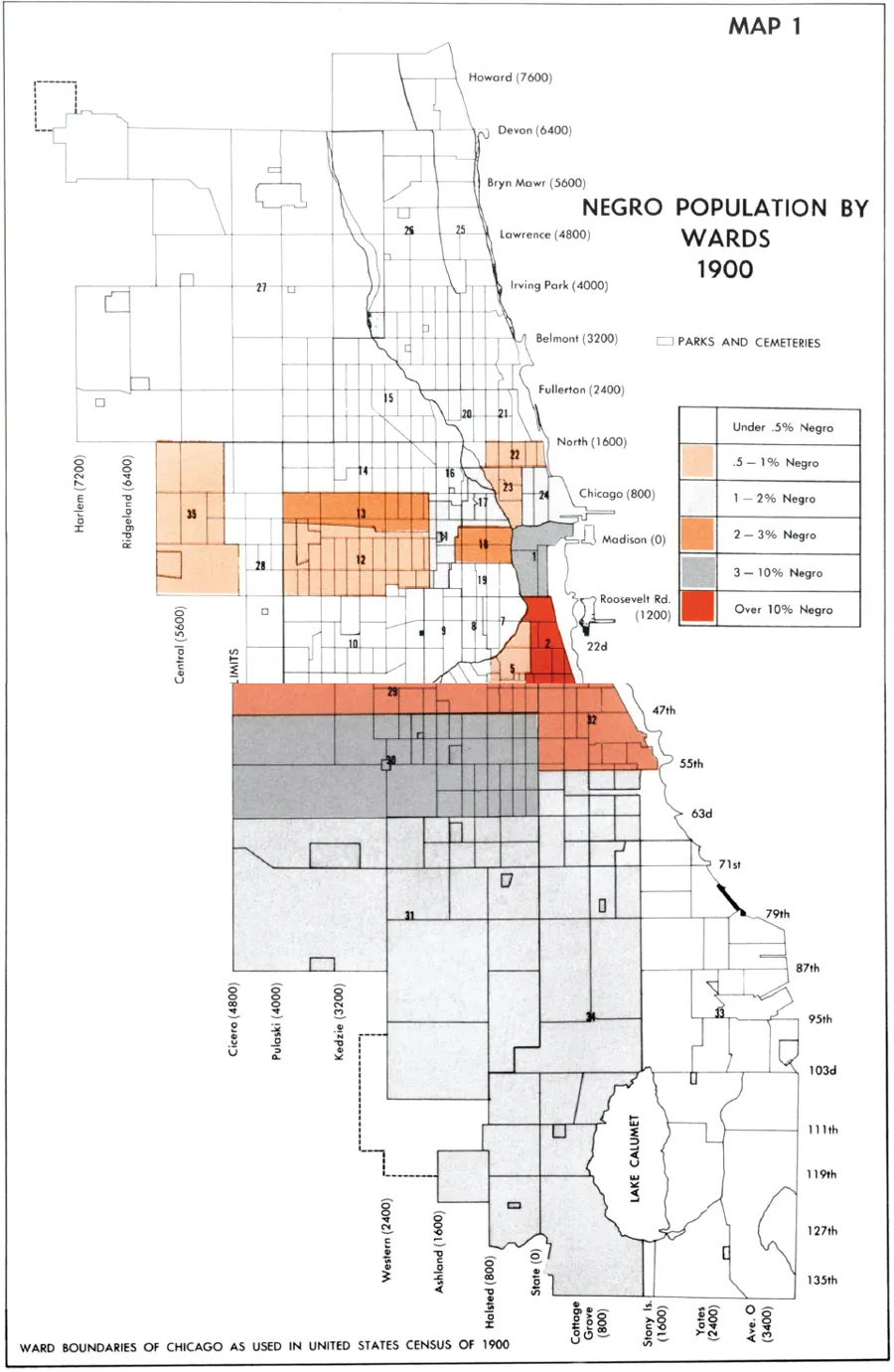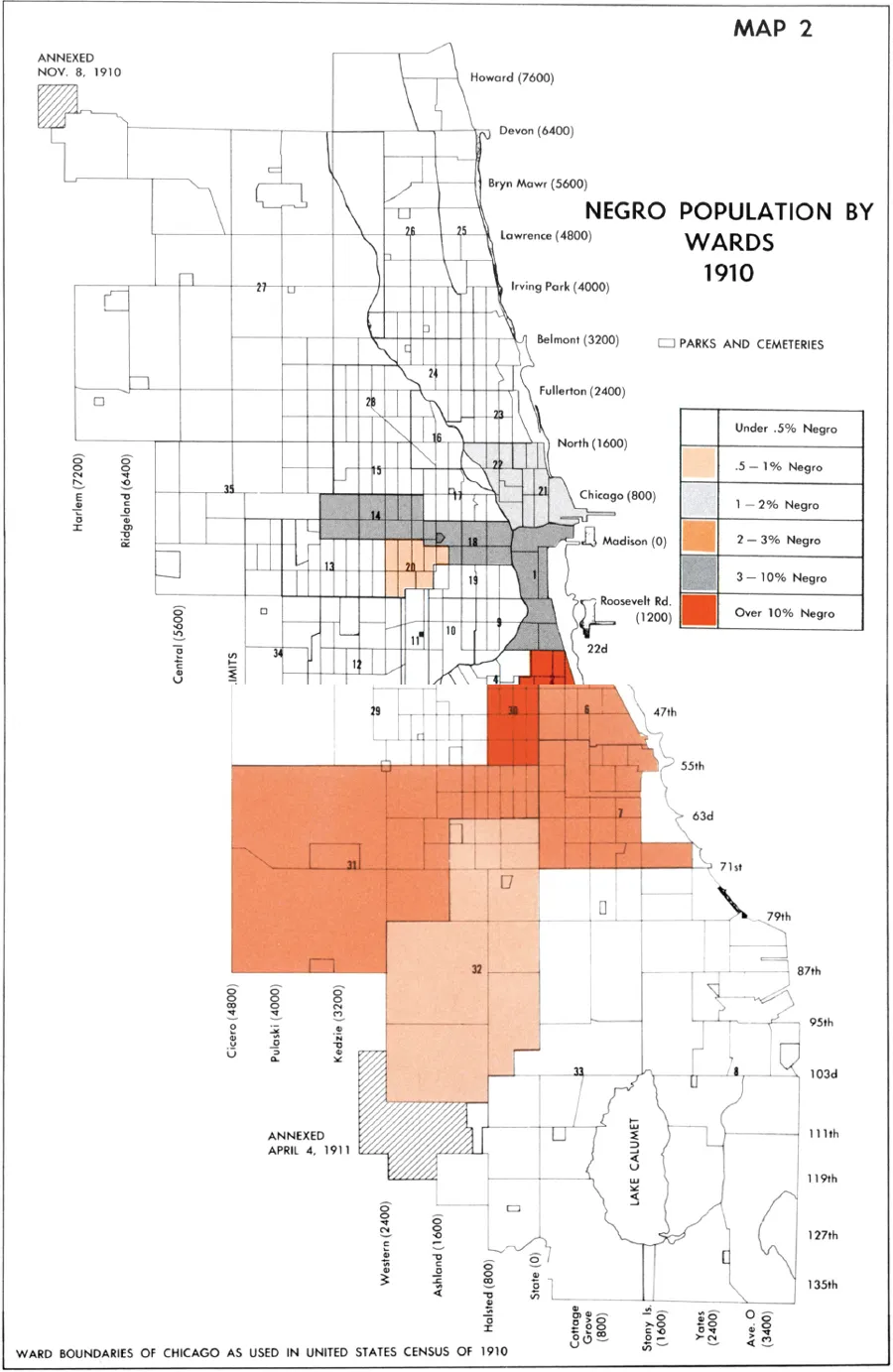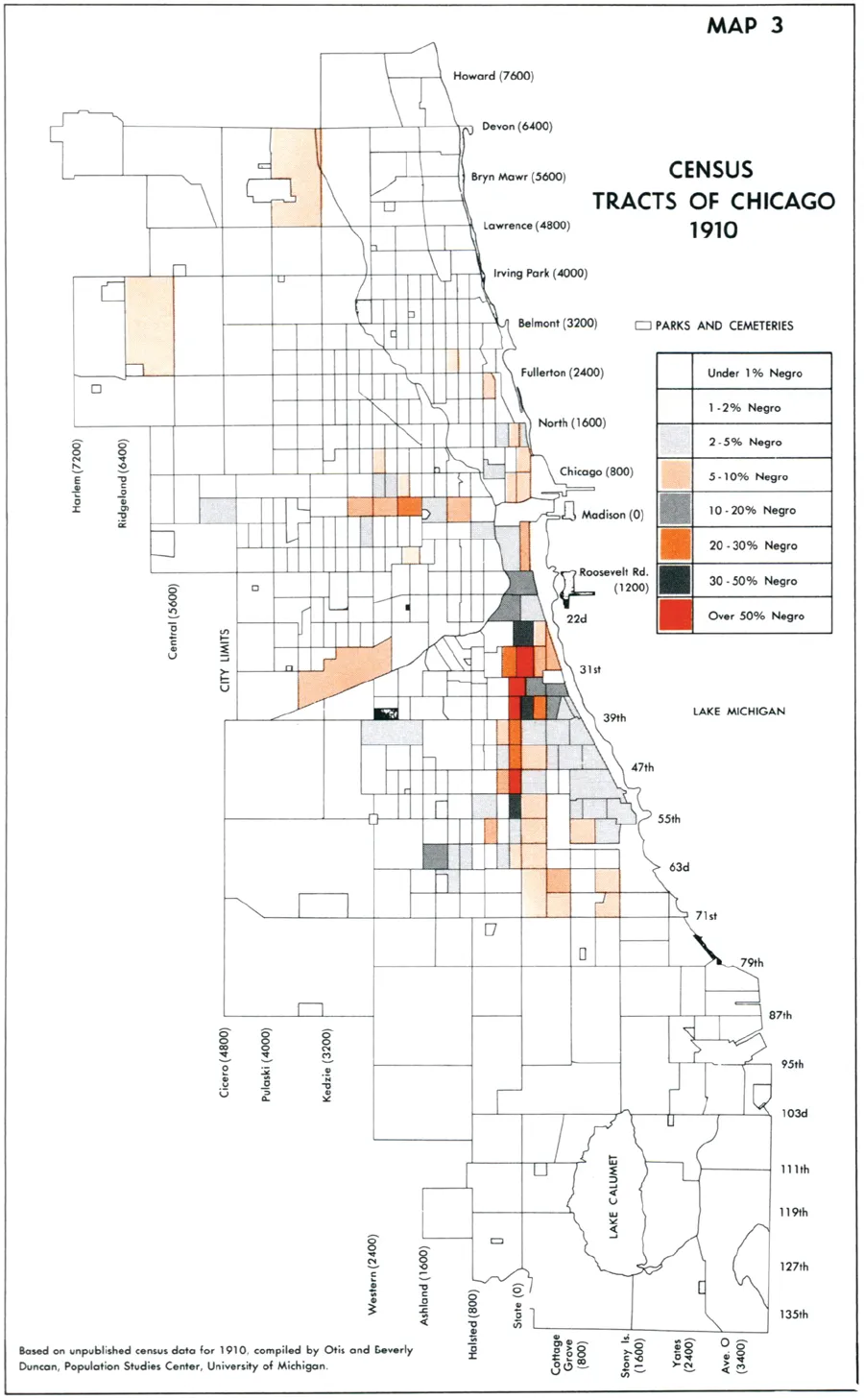
eBook - ePub
Black Chicago
The Making of a Negro Ghetto, 1890-1920
Allan H. Spear
This is a test
Share book
- English
- ePUB (mobile friendly)
- Available on iOS & Android
eBook - ePub
Black Chicago
The Making of a Negro Ghetto, 1890-1920
Allan H. Spear
Book details
Book preview
Table of contents
Citations
About This Book
Allan Spear explores here the history of a major Negro community during a crucial thirty-year period when a relatively fluid patter of race relations gave way to a rigid system of segregation and discrimination. This is the first historical study of the ghetto made famous by the sociological classics of St. Clair Drake, E. Franklin Frazier, and others—by the novels of Richard Wright, and by countless blues songs. It was this ghetto that Martin Luther King, Jr., chose to focus on when he turned attention to the racial injustices of the North. Spear, by his objective treatment of the results of white racism, gives an effective, timely reminder of the serious urban problems that are the legacy of prejudice.
Frequently asked questions
How do I cancel my subscription?
Can/how do I download books?
At the moment all of our mobile-responsive ePub books are available to download via the app. Most of our PDFs are also available to download and we're working on making the final remaining ones downloadable now. Learn more here.
What is the difference between the pricing plans?
Both plans give you full access to the library and all of Perlego’s features. The only differences are the price and subscription period: With the annual plan you’ll save around 30% compared to 12 months on the monthly plan.
What is Perlego?
We are an online textbook subscription service, where you can get access to an entire online library for less than the price of a single book per month. With over 1 million books across 1000+ topics, we’ve got you covered! Learn more here.
Do you support text-to-speech?
Look out for the read-aloud symbol on your next book to see if you can listen to it. The read-aloud tool reads text aloud for you, highlighting the text as it is being read. You can pause it, speed it up and slow it down. Learn more here.
Is Black Chicago an online PDF/ePUB?
Yes, you can access Black Chicago by Allan H. Spear in PDF and/or ePUB format, as well as other popular books in Sciences sociales & Sociologie. We have over one million books available in our catalogue for you to explore.
Information
Topic
Sciences socialesSubtopic
SociologiePART I
THE RISE OF THE GHETTO, 1890–1915
CHAPTER 1
THE PHYSICAL GHETTO
Between 1890 and 1915, the Negro population of Chicago grew from less than fifteen thousand to over fifty thousand. Although this growth was overshadowed by the massive influx of Negroes during and after World War I, this was nevertheless a significant increase. By the eve of World War I, although Negroes were still a minor element in the city’s population, they were far more conspicuous than they had been a generation earlier. The population increase was accompanied by the concentration of Negroes into ever more constricted sections of the city. In the late nineteenth century, while most Negroes lived in certain sections of the South Side, they lived interspersed among whites; there were few all-Negro blocks. By 1915, on the other hand, the physical ghetto had taken shape; a large, almost all-Negro enclave on the South Side, with a similar offshoot on the West Side, housed most of Chicago’s Negroes.
Migration was the major factor in the growth of the Negro community, and most migrants were coming from outside of the state. Over 80 per cent of Chicago’s Negro population in 1900 was born in states other than Illinois. The largest portion of these migrants originated in the border states and in the Upper South: Kentucky, and Missouri, in particular, had sent large groups of Negroes to Chicago. The states of the Deep South were, as yet, a secondary source of Chicago’s Negro population; only 17 per cent had come from these states as opposed to 43 per cent from the Upper South. The states located directly south of Chicago supplied a larger segment of the population than the southeastern states, but there were sizable groups born in Virginia and Georgia.1
From the beginning of Chicago’s history, most Negroes had lived on the South Side. As early as 1850, 82 per cent of the Negro population lived in an area bounded by the Chicago River on the north, Sixteenth Street on the south, the South Branch of the river on the west, and Lake Michigan on the east.2 The famous South Side black belt was emerging—a narrow finger of land, wedged between the railroad yards and industrial plants just west of Wentworth Avenue and the fashionable homes east of Wabash Avenue. By 1900, the black belt stretched from the downtown business district as far south as Thirty-ninth Street. But there were also sizable Negro enclaves, usually of a few square blocks each, in several other sections of the city.3 The Thirteenth Ward Negro community stretched along West Lake Street from Ashland to Western. The Eighteenth Ward Negroes lived in the old immigrant neighborhood on the Near West Side near Hull House. On the Near North Side, Negroes had begun to settle in the Italian Seventeenth Ward. And on the South Side, beyond the black belt, communities of upper- and middle-class Negroes had emerged in Hyde Park, Woodlawn, Englewood, and Morgan Park.4
TABLE 1
NEGRO POPULATION OF CHICAGO 1850–1930

SOURCE: U.S. Census Reports, 1850–1930.
TABLE 2
STATE OF BIRTH OF NATIVE NON-WHITES CHICAGO, 1900


SOURCE: U.S. Twelfth Census, 1900, vol. 1, Population, part 1, pp. 706–25. Derived by adding figures in Tables 31 and 32 and subtracting from figures in Table 30.
a Middle West totals (including Illinois): 10, 276 and 34.5 per cent.
Despite this concentration of Negroes in enclaves, the Negro population of the city was still relatively well distributed in 1900. Nineteen of the city’s thirty-five wards had a Negro population of at least .5 per cent of the total population of the ward and fourteen wards were at least 1 per cent Negro. Only two wards had a Negro population of more than 10 per cent. In 1898, just over a quarter of Chicago’s Negroes lived in precincts that were more than 50 per cent Negro, and over 30 per cent lived in precincts that were at least 95 per cent white.5 As late as 1910, Negroes were less highly segregated from native whites than were Italian immigrants.6
MAPS




TABLE 3
NEGRO POPULATION BY WARD CHICAGO, 1900 AND 1910

SOURCES: U.S. Twelfth Census, 1900, Bulletin no. 72, July 13, 1901, p. 8; U.S. Thirteenth Census, 1910, Statistics for Illinois, pp. 644–46.
a Figures for 1900 and for 1910 are not comparable on a one-to-one basis because of changes in the ward boundaries (see Maps 1 and 2).
b Table includes data only for those wards with at least 0.5 per cent Negro population. Blank spaces indicate wards with under 0.5 per cent Negro population.
The decade 1900 to 1910 saw several significant changes in the population pattern of Negroes in Chicago. The growth rate, which had far outpaced the white growth rate in the 1890’s, declined from 111 per cent to 46 per cent, and the proportion of Negroes in the population increased from 1.9 per cent to only 2 per cent. Yet despite this stabilization, the Negro population was still composed largely of migrants. Over 77 per cent of Chicago’s Negroes were born outside of Illinois. This represents only a slight drop from 1900 and was almost five times as great as the corresponding figure for white Chicagoans.7 Only three major Negro communities in the country—Los Angeles, Denver, and Oklahoma City, all young Western cities with highly mobile populations—had higher proportions of out-of-state migrants than Chicago. Even such burgeoning industrial centers as Detroit, Pittsburgh, and Cleveland had a lower percentage of Negroes born in other states.8
TABLE 4
CONCENTRATION OF NEGROES IN CHICAGO 1898–1920

SOURCES: Paul Cressy, “The Succession of Cultural Groups in the City of Chicago,” unpublished doctoral dissertation, University of Chicago, 1930, p. 93; unpublished census data for the city of Chicago, 1910, compiled by Otis and Beverly Duncan, Population Studies Center, University of Michigan; Ernest W. Burgess and Charles Newcomb, editors, Census Data of the City of Chicago, 1920, Chicago, University of Chicago Press, 1931.
a Residence areas in 1898 refer to precincts; in 1910 and 1920 to census tracts.
b 1898 figures are based on a school census.
The concentration of Negroes in enclaves was clearly increasing throughout this period. By 1910, over 30 per cent lived in predominantly Negro sections of the city and over 60 per cent in areas that were more than 20 per cent Negro. Whereas in 1900 nineteen of thirty-five wards had been over .5 per cent Negro, this figure was reduced to thirteen in 1910. Furthermore, the second and third wards, which included the heart of the black belt, were now 25 per cent Negro, while in 1900 only one ward had even approached that figure.9
Negro residential patterns for 1910 can be seen most clearly through the use of census tract data.10 Of 431 census tracts in the city, Negroes could be found in all but ninety-four; eighty-eight were at least 1 per cent Negro. Four tracts were over 50 per cent Negro, but no tract was more than 61 per cent Negro. Despite greater concentration, therefore, there were still few all-Negro neighborhoods in Chicago.
The eight or nine neighborhoods that had been distinguishable as areas of Negro settlement in 1900 remained the core of the Chicago Negro community in 1910. The principal South Side black belt was slowly expanding to accommodate the growing population. Not only did Negroes push steadily southward, but the narrow strip of land that made up the black belt began to widen as Negroes moved into the comfortable neighborhood east of State Street. By the end of the decade, Negroes could be found as far east as Cottage Grove Avenue.11
Statistical data, then, reveal several definite trends in the pattern of Negro population in Chicago in the early twentieth century. The growth rate between 1900 and 1910 had decreased from the previous decade, but was still 50 per cent greater than that of whites. Most of the population increase was the result of migration, particularly from the nearby border states. Negroes could be found throughout much of the city and the Negro neighborhoods were by no means exclusively black. But the concentration of Negroes in two enclaves on the South and West Sides was increasing. As the population grew, Negroes were not spreading throughout the city but were becoming confined to a clearly delineated area of Negro settlement.
TABLE 5
STATE OF BIRTH OF ILLINOIS NEGROES 1900–1910


SOURCES: U.S. Twelfth Census, 1900, vol. 1, Population, part 1, pp. 702–705; U.S. Bureau of the Census, Negro Population in the United States, Washington, Government Printing Office, 1918, pp. 75–79.
a Middle West totals (including Illinois): 1900–36,612 and 43.3 per cent; 1910–44,216 and 40.9 per cent.
b Includes Indian Territory.
The increasing physical separation of Chicago’s Negroes was but one reflection of a growing pattern of segregation and discrimination in early twentieth-century Chicago. As the Negro community grew and opportunities for interracial conflict increased, so a pattern of discrimination and segregation became ever more pervasive. And perhaps the most critical aspect of interracial conflict came as the result of Negro attempts to secure adequate housing.
The South Side black belt could expand in only two directions in the early twentieth century—south and east. To the north lay the business district, which was moving south; in fact, commercial and light industrial concerns were pushing Negroes out of the area between Twelfth and Twenty-second Streets. West of Wentworth Avenue was a district of low-income immigrant homes, interspersed with railroad yards and light industry; the lack of adequate housing made this area undesirable for Negro expansion. East of State Street, on the other hand, was a neighborhood suitable for Negro residential requirements. This area, bounded by Twelfth and Thirty-ninth Streets, State Street and Lake Michigan, had, in the 1880’s and early 1890’s, included the most fashionable streets in the city—Prairie and Calumet Avenues. But by 1900, the wealthy residents were moving to the North Side, leaving behind them comfortable, if aging, homes. South of Thirty-ninth Street was an even more desirable residential area—Kenwood and Hyde Park—and across Washington Park from the southern extremity of the black belt were the new and attractive communities of Woodlawn and Englewood. In these areas, between 1900 and 1915, the lines were drawn in the struggle for housing that would subsequently lead to full-scale racial war. If no major battle was fought before 1915, there were at least several preliminary skirmishes that set the pattern for future, and more serious, confrontations.12
Negro expansion did not always mean conflict, nor did it mean that a neighborhood would shortly become exclusively black. In 1910, not more than a dozen blocks on the South Side were entirely Negro,13 and in many mixed areas Negroes and whites lived together harmoniously.14 But as Negroes became more numerous east of State and south of Fifty-first, friction increased and white hostility grew. When a Negro family moved into a previously all-white neighborhood, the neighbors frequently protested, tried to buy the property, and then, if unsuccessful, resorted to violence to drive out the interlopers. In many cases, the residents organized to urge real estate agents and property owners to sell and rent to whites only. The whites often succeeded in keeping Negroes out, at least temporarily. When their efforts failed, they gradually moved out, leaving the neighborhood predominantly, although rarely exclusively, Negro.
Such incidents occurred with only minor variations throughout the prewar period. In 1900, three Negro...